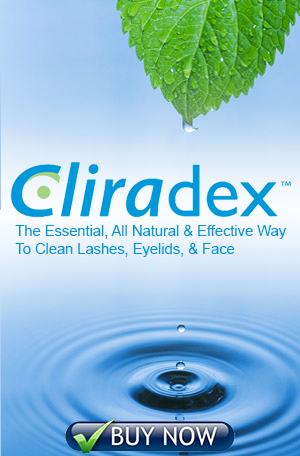
BlephEx…
The First and Only Doctor Treatment for Blepharitis
- Over 30% of all patients suffer from some type of blepharitis symptoms.
- BlephEx is a new, in-office procedure that allows your doctor to take an active role in treating blepharitis.
- BlephEx reduces scurf and bacterial debris, the main causes of inflammatory lid disease, and improves the overall health of the eyelid.
- Patients will finally enjoy a life free from the chronic and irritating symptoms associated with blepharitis.
- The BlephEx treatment is well tolerated and only takes a few minutes to perform.
- BlephEx can save the patient hundreds of dollars in the costs of prescription drops and artificial tears.
- Call Primary Eye Care Associates for the latest in eyecare technology, and see if BlephEx is right for you.
What is Blepharitis?
Blepharitis is a chronic, inflammatory disease of the eyelids caused by an overgrowth of normal bacteria living along the lid and the base of the eyelashes. Anyone can get blepharitis at any age, but the prevalence increases with age, since as we get older, we make fewer natural antibodies in our tears. This overgrowth of bacteria produces a biofilm that traps scurf and debris along the eyelashes and harbors bacterial exotoxins along the lid margin. These exotoxins penetrate the eyelid tissue causing low-grade inflammation which adversely affects the tear glands, turning down tear production. Fewer tears containing fewer antibodies allow even more bacteria accumulate and a vicious cycle is established, leading to chronic irritation and dry eye.
Progressive Stages of Blepharitis
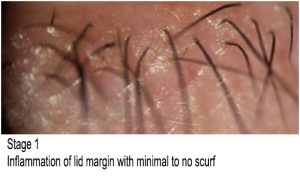
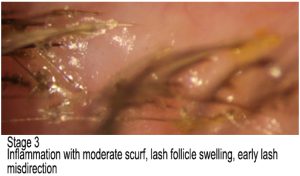
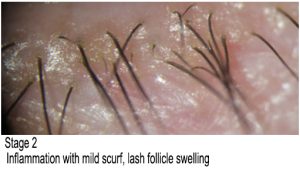
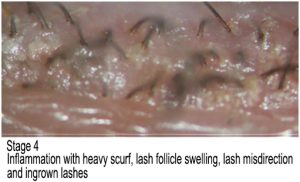
Since the eyelids are difficult to clean, this overgrowth of bacteria, biofilm, scurf and debris can accumulate over many years, and the exotoxin-induced inflammation can cause significant damage to the eyelid and tear glands. Now, thanks to BlephEx, we can precisely and safely, clean and exfoliate your eyelids and lashes, which will almost immediately improve your symptoms. More importantly, by completely removing the exotoxin-laden biofilm along the lid margin, your doctor can help you avoid the long-term inflammatory damage to your tear glands, preventing chronic dry eye syndrome.
How BlephEx Works
BlephEx is a painless in-office procedure performed by Primary Eye Care Associateseyecare professionals. A revolutionary new patented BlephEx handpiece is used to very precisely and carefully, spin a medical grade micro-sponge along the edge of your eyelids and lashes, removing scurf and debris and exfoliating your eyelids.

The patented micro-sponge is disposable and a clean one is used for each individual eyelid so bacteria is not spread between the lids.The eyes are rinsed well afterwards.
The procedure lasts about 6 -8 minutes and is well tolerated. Most patients simply report a tickling sensation. A numbing drop is usually placed in each eye prior to treatment for increased comfort.
After the procedure, the patient is instructed on how to maintain their clean eyelids with regular nightly lid hygiene. Since home treatments are only semi-effective, the procedure is typically repeated at 4-6 month intervals.
How BlephEx Works
If you suffer from one or more of the following symptoms, you may be suffering from blepharitis:
- Itching or scratchy eyes
- Foreign body sensation
- Tearing
- Crusting
- Redness/Inflammation
- Mattering
- Dry eyes
- Eye rubbing
Blepharitis can only be diagnosed by your eye doctor. Make sure to let your doctor know of your eye symptoms and inquire about BlephEx, the latest in eyecare technology for lid disease. There are several conditions which may affect the severity of blepharitis such as dry eye disease, allergies, seborrheic dermatitis, rosacea, age, contact lens wear, poor immune status, rheumatoid arthritis, Sjogrens disease, and androgen deficiency. If left untreated, blepharitis can lead directly or indirectly, to a number of eyelid diseases, such as:
Dry Eye Syndrome – Due to inflammatory down regulation of tears glands in the eyelids, and swelling with subsequent occlusion of tear excretory ducts. Treated with numerous artificial tears, cyclosporine drops, punctal plugs, night-time moisture chamber googles, bedtime lubricating ointments
Chalazions (styes) – Occlusion of Meibomian excretory ducts causing painful swelling of Meibomian gland with leakage of highly inflammatory oil components into surrounding tissue. Treated with hot compresses, lid scrubs, surgery.
CicatricialEctropion – outward turning of the lower eyelid due to chronic lid inflammation and scarring down of the structural support tissue of the eyelid. Results in severe dry eye syndrome, corneal scarring and vision loss. Treated by artificial tears, ointments, hyaluronic acid injection and surgery. May necessitate a corneal transplant if scarring of the cornea becomes severe.
InvolutionalEctropian – outward turning of the lower eyelid due to laxity and sagging of the lower lid caused by chronic inflammation and weakening of the eyelid support tissue. Treated by artificial tears, ointments and surgery.
CicatricialEntropion – inward turning of the lower eyelid due to chronic lid inflammation and scarring down of the structural support tissue of the eyelid. Results in chronic irritation of the eye, corneal ulceration and scarring, and vision loss. Treated by surgery. May necessitate a corneal transplant if scarring of the cornea becomes severe.
InvolutionalEntropian – inward eversion of the lower eyelid due to laxity and sagging of the lower lid caused by chronic inflammation and weakening of the eyelid support tissue. Treated surgery. May necessitate a corneal transplant if scarring of the cornea becomes severe.
Acquired Distichiasis – an extra row of lashes that grow from Meibomian glands that have undergone aberrant differentiation to hair follicles due to chronic inflammation. Their close proximity to the cornea results in irritation, abrasion and sometimes scarring of the cornea. Treatment is epilation of the lashes, either mechanical or using electrolysis.
Trichiasis– an inward turning of the lashes so that they abrade the corneal surface causing irritation, tearing, poor vision and occasionally corneal scarring. Caused by acute and chronic inflammation of the lid margin which disrupts the normal intra-lid anatomy surrounding the lash follicles. Treatment is epilation of the lashes, either mechanical or using electrolysis.
Before and After Treatment
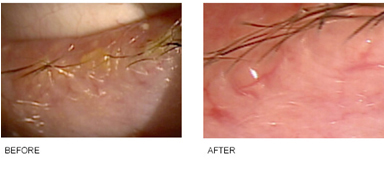
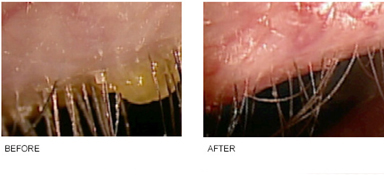
What is Claridex?
